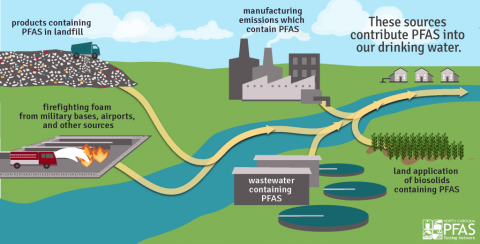Per– and polyfluoroalkyl substances, or PFAS, are a large group of human-made chemicals used for decades in many products, such as firefighting foam, water-resistant clothing, stain-resistant carpets, non-stick cookware, food packaging, and cleaning products. PFAS are used in products for their strength and resistance to heat, water, and oil. These manufactured chemicals do not break down or disappear naturally in the environment, which is why they are called “forever chemicals.” They can cycle through the air, soil, and water and enter the food chain.
People can be exposed to PFAS in drinking water, food, indoor dust, some consumer products, and workplaces. One of the main sources for potential exposure is drinking water that has been contaminated by PFAS.
When PFAS are made, used, disposed of, or spilled near water sources, like rivers, aquifers or wells, the chemicals can get into drinking water. Because PFAS do not break down easily, they may remain in water supplies for many years and have been found in people, wildlife, and fish.
PFAS are a public health concern because they:
- Can impact human health.
- Can build up in animals, fish, birds, plants, and people.
- Don’t break down in water, soil, or air.
- Can travel large distances in water or air.
Not all PFAS have the same impact on people or the environment. Watch the video “What are PFAS?” from the Minnesota Pollution Control Agency to learn more.
How to check your water source for PFAS
The presence of PFAS in drinking water can only be determined through laboratory testing. You can’t see, taste, or smell PFAS in your water. Steps for testing drinking water will depend on if the property’s water source is a private or public water system.
Private water systems and individual wells
People who are concerned the water from their private wells may be contaminated can conduct testing for PFAS. The cost of testing is about $300-$600. A water sample can be sent to one of the PFAS drinking water accredited labs (Russian, Ukrainian)
Because PFAS can be in many household items, it is easy to contaminate a water sample. Before deciding to test water from a private well, discuss proper sampling steps with the selected accredited lab to ensure results are accurate.
Private water system and well owners considering testing can use the state Department of Health's PFAS testing results dashboard to see if PFAS have been detected nearby.
For more information, see the common questions about PFAS and private wells (Spanish, Russian, Ukrainian).
Public water system
Contact the agency that sends your water bill to ask if they have tested for PFAS and whether any actions have been taken to reduce the level of PFAS. Water systems are required to test for PFAS and share results under the 2021 Washington State Board of Health rule.
- City of Battle Ground
- City of Camas
- City of Ridgefield
- City of Vancouver
- City of Washougal
- Clark Public Utilities
Unsure who provides your water? If you do not receive a water bill, check with your landlord, property management or whoever you rent through.
Frequently asked questions
For more answers to common questions, visit Washington State Department of Health’s PFAS frequently asked questions.
Clark County residents can contact Public Health with questions, concerns or comments about PFAS in drinking water by calling 564.397.8000 or by clicking the button below.
Additional resources
- How to reduce PFAS in your drinking water
- Home water treatment for PFAS (Spanish) (Russian) (Tagalog) (Ukrainian) (Vietnamese)
- PFAS Point-of-use filter options
- Video: How to select a point-of-use water filter or bottled water
- PFAS in drinking water: Safety questions about gardening, livestock, and pets
- PFAS testing results dashboard
- EPA’s health advisory levels
- Department of Ecology – PFAS
- EPA - PFAS
- Agency for Toxic Substances and Disease Registry – PFAS


